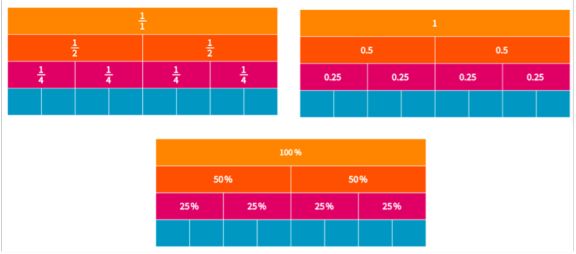By Tayla Zondagh, primary mathematics specialist and classroom teacher Grade 3 Orange
An important focus was the distinction between writing and solving word problems. When solving, students should present a clear number sentence, their working out, and an answer sentence. In contrast, writing a word problem involves offering relevant information, identifying an unknown factor, and posing a question that requires at least one mathematical operation.
Using Strip Diagrams
Strip diagrams (or tape diagrams) are effective tools for visualising word problems. These horizontal rectangles represent quantities, with their lengths illustrate the value of each quantity and their locations depict the relationships between them. A strip diagram can help clarify this relationship and guide students to the correct operation.

Can you create a word problem to match each of these strip diagrams?

Visual aids and manipulatives
Numicon is a manipulative that helps students visualise fractions, decimals, and percentages. For instance, to find a quarter of 20, students can demonstrate that half of 20 is 10, and half of 10 is 5. This visual representation reinforces their understanding of these concepts.
Virtual manipulatives from Polypad were explored. These support students to make connections between concepts, such as fractions, decimals and
percentages. For instance, when asking, “What is 25% of 80?”, students can
visually understand that if the top is represented as 80%, then 25% would equal
20.

Building number sense: strategies for multiplication and division
Multiplication involves making equal groups and division distributes items into equal parts. The box method and division by chunking were shared as effective strategies taught from Grade 4.
Universal number screeners
Introduced this academic year, these screeners are conducted three times a year from Kindergarten 2. The purpose is to measure progress and identify areas where students may need additional support. It is also valuable in measuring student’s knowledge and skills to understand prior knowledge, set learning goals as well as identify strengths and areas of improvement.Support at home
We encourage you to actively support your child at home by making mathematics visual and using real-world applications. Strip diagrams and virtual manipulatives can enhance your child’s conceptual understanding. Together, we can build a strong foundation in mathematics that will enhance student’s confidence and curiosity.
School parents can find the presentation uploaded in the For Parents section of the website.